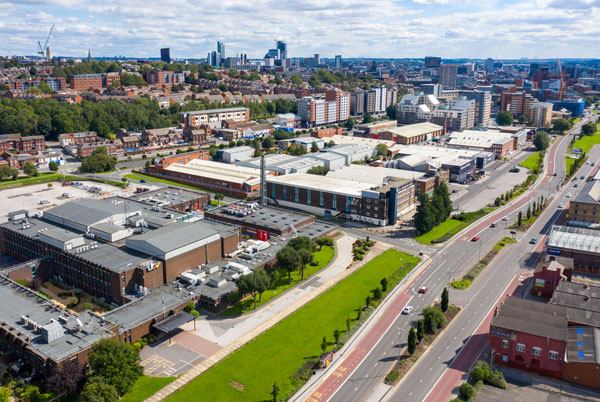Toxic air pollution in Leeds was above legal limits in 2021 after the city council chose not to proceed with a government-mandated Clean Air Zone (CAZ).
Despite the impact of the pandemic on travel, an official report disclosed that levels of toxic nitrogen dioxide at seven locations were higher than what Leeds City Council called ‘the national air quality objectives’. In fact, the maximum levels in the Air Quality Directive are legally binding.
It also acknowledged that 54 deaths in 1,000 in the city are linked to poor air quality.

ITV studios, Kirkstall Road, Leeds, with the city centre in the background
An air quality monitor near Kirkstall Road in the city measured higher than permitted pollution levels ‘and is at a location where some people are likely to be exposed for an hour or longer’.
The council sought to play down exceedances in other areas by arguing that ‘people are unlikely to be exposed to pollution for an hour or longer at these locations’.
Officials stated that progress had been made, claiming that ‘changing travel behaviours, a faster than average transition to plug-in vehicles, and major highways improvements are all likely to have contributed to the city’s healthier air’.
They added that the city’s six designated Air Quality Management Areas (AQMAs – neighbourhoods previously identified as being unlikely to meet clean air standards – 'were compliant with national regulations and continue to improve'.
The council now plans to formally revoke five of the six AQMA designations this year, although the AQMA at Pool-in-Wharfedale will be kept under review for at least another year.
The latest data showing illegal pollution levels in some areas of the city was from 2021, suggesting that the council had sat on the results for some time. It attributed this to ‘a rigorous verification process’. However, 2022 data will be completed and published in a much shorter timeframe and is due for release later this year.
Although Leeds City Council was one of several cities directed by the Government to introduce a charging Clean Air Zone to tackle illegal levels of pollution, initially in 2020, later that year it decided not to implement the plan, claiming that the proposal had already led to an accelerated take-up of cleaner vehicles, leading to significant air quality improvements.
Mohammed Rafique, the council’s executive member with responsibility for climate and air quality, described the data showing illegal levels of toxic air pollution as ‘hugely reassuring’, arguing that it ‘confirms that Leeds’ air quality hasn’t returned to pre-pandemic levels and is continuing to get better’.
He added: ‘Despite these improvements, 54 in 1,000 deaths in Leeds can still be linked to air unhealthy air, so it is vitally important that we continue taking further action to bring down pollution levels even more. This council will lead by example to do just that.’
Register now for full access
Register just once to get unrestricted, real-time coverage of the issues and challenges facing UK transport and highways engineers.
Full website content includes the latest news, exclusive commentary from leading industry figures and detailed topical analysis of the highways, transportation, environment and place-shaping sectors.
Use the link below to register your details for full, free access.
Already a registered? Login